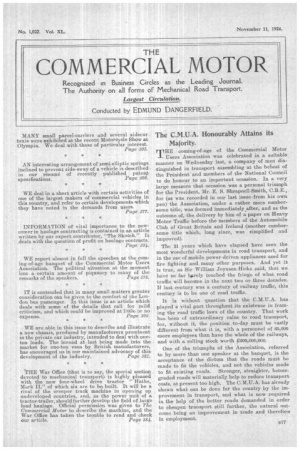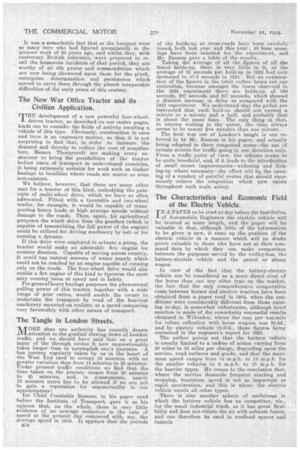The C.M.U.A. Honourably Attains its Majority.
Page 1

Page 2

If you've noticed an error in this article please click here to report it so we can fix it.
THE coming-of-age of the Commercial Motor Users Association was celebrated in a suitable manner an Wednesday last, a company of men distinguished in transport assembling at the behest of the President and members of the National Council to do honour to art important occasion. In a very large measure that occasion was a personal triumph for the President, Mr. E. S. S.hrapnell-Smith, C.B.E., for (as was recorded in our last issue-from his own pen) the Association, under a rather more cumbersome title, was formed immediately after, and as the outcome of, the delivery by him of a paper on Heavy Motor Traffic before the members of the Automobile Club of Great Britain and Ireland (another cumbersome title which, long since, was simplified and improved).
The 21 years which have elapsed have seen the most wonderful developments in road transport, and in the use of mobile power-driven appliances used for fire fighting and many other purposes. And yet it is true, as Sir William Joynson-Hicks said, that we have so far barely touched the fringe of what road traffic will become in the next two or three decades. If last century was a century of railway traffic, this century is to be one of road traffic.
It is without question that the C.M.U.A. has played a vital part throughout its existence in framing the road traffic laws of the country. That work has been of extraordinary value to road transport, for, without it, the position .'to-day must be vastly different from what it is, with a personnel of 65,000 more employees than have the whole of the railways, and with a rolling stock worth 005,000,000.
One of the triumphs of the Association, referred to by more than one speaker at the banquet, is the acceptance of the dictum that the roads must be made to fit the vehicles, and not the vehicles made to fit existing roads. Stronger, straighter, bettergraded roads will materially help to reduce transport costs, at present too high. The C.M.U.A. has already shown what can be done for the country by the improvement in transport, and what is now required ia the help of the better roads demanded in order to cheapen transport still further, the natural outcome being an improvement in trade and therefore in employment. It was a remarkable fact that at the banquet were so many men who had figured prominently in the pioneer work of 20 years ago, and whilst they, with customary British tolerance, were prepared to recall the humorous incidents of that period, they a.ra worthy of all the praise and commendation which are now being showered upon them for the pluck, enterprise, determination and persistence which served to carry them through the almost insuperable difficulties of the early years of this century.
The New War Office Tractor and its Civilian Application.
mHE development of a new powerful four-wheel-1driven tractor, as described on our centre pages, leads one to consider the fields of activity awaiting a. vehicle of this type. •Obviously, construction in onesand twos is an expensive matter, so that it is not surprising to -find that, in order to increase the demand and thereby to reduce the cost of reanufaeture, Messrs. Thornycroft are making every endeavour to bring the possibilities of the tractor before users of transport in undeveloped countries, it being extremely suitable for work such as timberhaulage in localities where roads are scarce or even non-existent.
We believe, however, that there are many other uses for a tractor of this kind, embodying the principle of multi-wheel drive, which we have so often advocated. Fitted with a, turntable and two-wheel trailer, for example, it would be capable of transporting heavy loads at high average speeds without damage to the roads. Then, again, for agricultural purposes the winch drive from the gearbox (which is capable of transmitting the full power of the engine) could be utilized for driving machinery by belt or for running a dynamo.
If this drive were employed to actuate a pump, the tractor would make an admirable fire engine for country districts. Capable of moving across country, it could tap natural sources of water supply which could not be reached by an engine capable of running only on the roads. The four-wheel drive would also enable a fire engine of this kind to traverse the most miry country lanes at speed and in safety.
For general-heavy haulage purposes the phenomenal pulling power of this tractor, together with a wide range of gear ratios, would enable the owner to undertake the transport by road of the heaviest machinery mounted on trailers, at a speed comparing very favourably with other means of transport.
The Tangle in London Streets.
MORE than one authority has recently drawn attention to the gradual slowing down of London traffic, and we should have said that on a great many of the through routes it now unquestionably takes longer time to -accomplish one's journeys. A. bus journey regularly taken by us in the heart of the West End used to occupy 16 minutes, with no greater variation than from 14 minutes to 20 minutes. Under present, traffic conditions we find that the time taken on the journey ranges from 20 minutes to 25 minutes, and, in consequence, nearly 10 minutes extra has to be allowed if we are not to gain a reputation for unpunctuality in our appointments 1 Yet Chief Constable Eassom, in his paper read before the Institute of Transport, gave it as his opinion that, on the whole, there is very little evidence of an average reduction in the rate of speed at the present day compared with, say, the average speed in 1919. It appears that the periods 1318 of the holds-up at cross-roads have been carefully timed, both last year and this year ; 50 busy crossings have been selected for the experiment, and Mr. Bassom gave a table of the results. Taking the average of all the figures of all the timed holds-up, there is very little in it, as the average of 53 seconds per hold-up in 1923 had only increased to 57.6 seconds in 1924. But an examination of the figures in the table rather bears out our contention, because amongst the times observed in the 1924 experiment there are holds-up of 330 seconds, 287 seconds and 207 seconds, which showed a distinct increase in delay as compared with the 1923 experiment. We understand that the police are instructed that each hold-up should not exceed a minute or a minute and a half, and probably that is about the usual time. The only thing is that, to anyone waiting in the queue, the time always seems to he nearer five minutes than one minute.
The best way out of London's tangle is one referred to by Mr. Bassom in his paper, and actually being adopted in three congested areas—the use of certain streets for traffic going in one direction only. -From a traffic point of view, the scheme seems to be quite beneficial, and, if it leads to the introduction of small street improvements—widening and linking-up where necessary—the effect will be the opening of a number of parallel routes that should enormously relieve the congestion which now exists throughout each main artery.
The Characteristics and Economic Field of the Electric Vehicle.
TN A PAPER to be read to-day before the Institution of Automobile Engineers the electric vehicle will be treated at some length, and the paper will be valuable in that, although little of the information to be given is new, it sums up the position of the electric vehicle in a manner which will no doubt prove valuable to those who have not at their command data by which they can make comparison between the purposes served by the trolley-bus, the battery-electric vehicle and the petrol or steam wagon.
In view of the fact that the battery-electric vehicle can be considered as a more direct rival of the horse than can any other type on the market, the fact that the only comprehensive comparative costs between horses and electric traction have been obtained from a paper read in 1916, when the conditions were considerably different from those existing to-day, is somewhat unfortunate, although brief mention is made of the remarkably successful results obtained in Willesden, where the cost per ton-mile for refuse collection with horse wagons was 30.6d., and by electric vehicle 12.37d., these figures being contained in the engineer's report for 1923.
The author points out that the battery vehicle is usually limited to a radius of action varying from 30 miles to 50 miles per charge, depending upon the service, road surfaces and grade, and that the maximum speed ranges from 14 m.p.h. to 18 m.p.h. for the smaller vehicles to 9 m.p.h. to 10 m.p.h. for the heavier types. He comes to the conclusion that, where the service demands frequent starting and stopping, maximum speed is not so important as rapid acceleration, and this is where the electric vehicle excels all other types.
There is also another sphere of usefulness in which the battery vehicle has no competitor, viz., for the small industrial truck, as it has great flexibility and does not vitiate the air with exhaust fumes, and can therefore be used in confined spaces and tunnels.






























